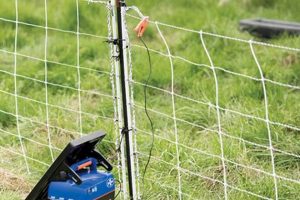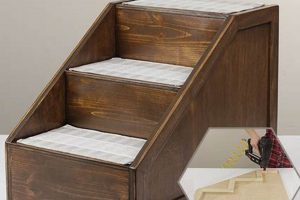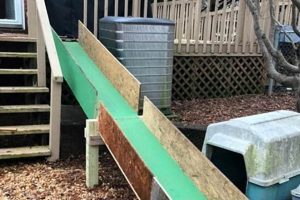The creation of elevated platforms designed to assist canines in reaching higher surfaces represents a significant trend in pet care. These structures, often built at home, provide accessibility solutions for small breeds, aging animals, or those with mobility limitations. Examples include tiered platforms constructed from wood or upholstered inclines made from foam, both intended to ease the strain of jumping.
The construction of these assistive devices offers numerous benefits. They reduce the risk of joint stress and injury, particularly for dogs prone to arthritis or intervertebral disc disease. Historically, owners might have resorted to lifting their pets, a practice that becomes physically demanding over time. These aids offer a practical and sustainable alternative, promoting canine independence and well-being.
The following sections will explore the considerations for material selection, design principles, and safety precautions involved in the creation of customized canine access solutions, ensuring both functionality and longevity.
Construction Recommendations
The following are guidelines to consider when building elevated platforms to aid canine accessibility. Adhering to these recommendations promotes structural integrity and animal safety.
Tip 1: Prioritize Structural Integrity: Use high-quality materials, such as solid wood or reinforced plywood, to ensure the structure can withstand the weight of the dog without buckling or collapsing. Reinforce joints with screws and wood glue.
Tip 2: Calculate Appropriate Dimensions: Measure the distance between the floor and the target surface (e.g., bed or sofa). Design the steps or ramp with a gradual incline and appropriate step height (typically 6-8 inches) to minimize strain on the dog’s joints.
Tip 3: Implement Non-Slip Surfaces: Cover the steps or ramp with carpet, rubber mats, or textured paint to provide secure footing. This prevents slips and falls, particularly for dogs with limited mobility.
Tip 4: Ensure Stable Base Construction: Design the base to be wide and stable to prevent tipping. Consider adding weight to the base for additional stability, especially for larger breeds.
Tip 5: Incorporate Safety Rails (for Ramps): If constructing a ramp, add side rails to prevent the dog from accidentally walking off the edge. The rails should be high enough to provide a sense of security without hindering movement.
Tip 6: Regularly Inspect the Structure: Conduct routine inspections for loose screws, worn surfaces, or any signs of damage. Promptly repair any issues to maintain safety and prevent accidents.
Tip 7: Consider Gradual Acclimation: Introduce the canine to the steps or ramp gradually, using positive reinforcement (e.g., treats and praise) to encourage use. Avoid forcing the dog to use the structure.
Following these recommendations when constructing elevated platforms for canine use will enhance safety, functionality, and longevity. These considerations are crucial for providing assistive devices that effectively support the animal’s mobility and well-being.
The subsequent section will discuss advanced design options and customization techniques for accommodating specific canine needs.
1. Dimensions
Dimensional accuracy is paramount in the successful creation of canine assistive platforms. Incorrect measurements or poorly proportioned elements compromise the functionality and safety of the finished product. The following outlines crucial considerations regarding dimensional aspects.
- Step Height
The vertical distance between each step directly impacts the ease of use. An ideal step height typically ranges from 6 to 8 inches, although adjustments are necessary for smaller breeds or those with severe mobility limitations. Steps that are too high increase strain on the joints, while steps that are too low might not provide adequate assistance.
- Step Depth
The horizontal distance of each step must accommodate the canine’s stride. Insufficient depth can lead to instability and an increased risk of falls. A minimum depth of 10 to 12 inches is recommended for most breeds, with larger dogs requiring greater depth. Proper step depth facilitates a comfortable and secure gait.
- Ramp Incline
The slope of a ramp directly affects its accessibility. A steep incline places excessive strain on the dog’s muscles and joints, defeating the purpose of the assistive device. An optimal incline is typically between 18 and 25 degrees. Gentler slopes are preferable for dogs with significant mobility issues.
- Overall Width
The width of the steps or ramp dictates the space available for the dog to move freely. Insufficient width can lead to hesitation and a higher risk of missteps. A minimum width of 12 inches is generally recommended, with wider structures providing increased stability and confidence.
Precise dimensional calculations and adherence to appropriate proportions are essential for ensuring that canine assistive platforms effectively support mobility and minimize the risk of injury. These parameters must be tailored to the individual dog’s size, breed, and physical capabilities to maximize the benefits of the constructed structure.
2. Materials
Material selection exerts a substantial influence on the safety, durability, and aesthetic appeal of canine assistive platforms. The choice of materials directly impacts structural integrity, ease of maintenance, and the overall suitability of the structure for its intended user. Careful consideration of material properties is therefore critical to the successful implementation of such projects.
- Wood
Wood, specifically solid lumber or plywood, represents a common choice for structural components due to its strength and workability. Hardwoods, such as oak or maple, offer superior durability but are more expensive and require greater effort for cutting and shaping. Softwoods, such as pine, are more affordable and easier to work with but are less resistant to wear and tear. Regardless of the specific wood type, proper sealing and finishing are necessary to protect against moisture damage and splintering.
- Carpeting/Upholstery
The application of carpeting or upholstery to the step or ramp surfaces provides essential traction and cushioning. Low-pile carpeting offers a secure grip, minimizing the risk of slips and falls. Upholstery foam padding adds an extra layer of comfort, particularly beneficial for dogs with sensitive joints. Selection of durable, stain-resistant materials is advised to withstand regular use and potential accidents.
- Fasteners
The selection of appropriate fasteners, such as screws, nails, and adhesives, is crucial for ensuring structural stability. Screws offer superior holding power compared to nails and are less likely to loosen over time. Wood glue, when used in conjunction with screws, further enhances joint strength. Stainless steel or galvanized fasteners are recommended for outdoor applications to prevent corrosion.
- Protective Coatings
The application of protective coatings, such as paint or varnish, serves both aesthetic and functional purposes. Paint can add color and visual appeal, while varnish provides a durable, waterproof barrier. Non-toxic, pet-safe coatings are essential to prevent any potential health hazards associated with ingestion or skin contact. Regular reapplication of protective coatings is necessary to maintain their effectiveness over time.
The interplay between these material considerations dictates the overall quality and longevity of canine assistive platforms. Thoughtful material selection, combined with sound construction techniques, yields a safe and supportive environment for canines with mobility challenges.
3. Stability
The structural integrity of a “diy dog steps and ramps” construction is paramount to its intended function. Stability, in this context, directly translates to the device’s ability to support a canine’s weight and movement without risk of collapse or unintended shifting. This requirement stems from the inherent vulnerability of animals using these aids; a sudden instability can result in falls, injuries, or a lasting aversion to the structure. For example, a ramp built with inadequate bracing may flex excessively under a dog’s weight, creating an unstable surface that the animal instinctively avoids. Similarly, steps lacking a solid foundation are prone to tipping, particularly when a dog places its weight unevenly, such as when ascending or descending rapidly. Therefore, the construction must prioritize a robust design that accounts for potential weight distribution and dynamic forces.
Achieving stability necessitates a multifaceted approach encompassing material selection, joint reinforcement, and base design. The use of high-quality materials, such as thick plywood or solid wood, provides a strong foundational framework. Joints, where individual components connect, require meticulous attention; screws and wood glue, rather than nails alone, provide a superior bond capable of withstanding repeated stress. The base design must distribute weight evenly across the floor, preventing localized pressure points that could lead to tipping. Widening the base or incorporating strategically placed support structures significantly enhances stability, especially for structures intended to accommodate larger breeds. Practical application involves calculating load-bearing capacity based on the expected weight and incorporating a safety margin to account for unforeseen stresses.
In conclusion, stability is not merely a desirable attribute of “diy dog steps and ramps” but a fundamental prerequisite for safe and effective use. Neglecting this aspect compromises the device’s purpose and potentially exposes the animal to harm. By adhering to sound construction principles and prioritizing a stable design, creators can ensure that these assistive devices provide reliable support, fostering both confidence and well-being in canine users. The challenge lies in balancing affordability and ease of construction with the rigorous stability requirements necessary for long-term safety and function.
4. Incline
The angle of incline presents a critical design consideration for “diy dog steps and ramps,” directly impacting the accessibility and safety of the structure for canines. A steep incline requires greater effort and range of motion, potentially exacerbating joint pain or instability in dogs with arthritis, hip dysplasia, or other mobility limitations. Conversely, an excessively shallow incline may necessitate a longer ramp, demanding more space and resources for construction. The optimal incline balances ease of use with practical spatial constraints. For example, a ramp intended for a small breed with minor joint stiffness might require a gentler incline than one designed for a larger, more agile dog. Failure to accurately assess the canine’s needs and match the incline accordingly can render the device ineffective or even harmful.
Practical application of incline principles involves careful measurement and calculation. The vertical rise (the height the dog needs to reach) and the available horizontal distance determine the achievable incline. A steeper rise-to-run ratio results in a steeper incline, while a shallower ratio creates a gentler slope. Builders should employ a protractor or angle finder to ensure the desired incline is accurately achieved during construction. The surface material also influences the perceived incline; a high-traction surface, such as carpet, allows for a steeper incline compared to a slippery surface like smooth wood. Real-world examples include ramps built for older dogs with significant mobility challenges, often employing very gentle inclines (e.g., 15-20 degrees) and textured surfaces to maximize accessibility and minimize the risk of slippage. This highlights the importance of tailoring the design to the specific needs of the user.
In summary, incline is a pivotal element in the design of “diy dog steps and ramps,” directly influencing their functionality and safety. Incorrect incline selection can negate the benefits of the device and potentially lead to injury. Achieving the appropriate incline requires careful assessment of the canine’s physical capabilities, accurate measurements, and thoughtful material selection. The challenge lies in balancing the need for accessibility with practical limitations in space and construction resources. Prioritizing this factor contributes significantly to creating assistive devices that genuinely enhance the quality of life for dogs with mobility challenges.
5. Safety
Safety forms the foundational principle underpinning the design and construction of “diy dog steps and ramps.” Its influence permeates every stage, from initial planning to final execution, reflecting the ethical responsibility to prevent harm to the animal using the structure. A failure to prioritize safety can lead to a range of negative outcomes, from minor scrapes and bruises to severe fractures and dislocations. For instance, steps constructed with sharp edges or a ramp lacking adequate traction pose a significant hazard, increasing the likelihood of falls, particularly for older dogs or those with pre-existing medical conditions. The cause-and-effect relationship is direct: compromised safety features result in an elevated risk of injury.
The practical significance of safety manifests in several key design elements. Non-slip surfaces, such as carpet or rubberized coatings, mitigate the risk of slippage, ensuring a secure footing. Rounded edges and concealed fasteners eliminate potential sources of cuts and abrasions. Sturdy construction, capable of withstanding the canine’s weight and movement, prevents structural collapse. The presence of side rails on ramps acts as a physical barrier, preventing accidental falls from the edge. An example of practical application involves using a non-toxic sealant on the wood, preventing chemical exposure to the animal. Each safety feature acts as a preventative measure, minimizing the potential for accidents and promoting confidence in the canine user.
In conclusion, safety is not merely an addendum to the construction of “diy dog steps and ramps,” but rather an integral component defining their value and utility. Prioritizing safety necessitates a thorough understanding of canine anatomy and biomechanics, coupled with meticulous attention to detail during the design and construction phases. The challenge lies in balancing cost-effectiveness with uncompromising safety standards. Ultimately, the success of these projects rests on the ability to create assistive devices that reliably support canine mobility while minimizing the risk of injury, thereby enhancing the animal’s quality of life.
Frequently Asked Questions
The following addresses prevalent inquiries pertaining to the construction and utilization of assistive devices designed to improve canine accessibility.
Question 1: What is the recommended weight capacity for canine steps and ramps?
The weight capacity depends directly on the materials used and the construction methods employed. Structures should be designed to support, at minimum, twice the weight of the largest anticipated canine user to account for dynamic forces during movement. Consult material specifications for load-bearing capabilities.
Question 2: How does one determine the appropriate step height for a canine?
Step height should be tailored to the canine’s size and mobility. As a general guideline, step heights ranging from six to eight inches are suitable for many breeds. Measure the dog’s leg length from the floor to the elbow to inform the optimal step height. Adjustments are necessary for animals with compromised joint function.
Question 3: What constitutes a safe ramp incline for canine use?
A safe ramp incline typically falls between 18 and 25 degrees. Steeper inclines increase the risk of strain and slippage. Gentler inclines are preferable for canines with mobility issues, though they require a longer ramp length. The inclusion of a non-slip surface is essential regardless of the incline.
Question 4: Which materials are best suited for outdoor canine access structures?
For outdoor applications, pressure-treated lumber or naturally rot-resistant woods, such as cedar or redwood, are recommended. Fasteners should be corrosion-resistant (e.g., stainless steel) to withstand exposure to the elements. A waterproof sealant or paint will further protect the structure from moisture damage.
Question 5: How can a canine be trained to use steps or a ramp effectively?
Introduce the structure gradually, using positive reinforcement techniques. Lure the canine with treats and praise as it approaches and interacts with the steps or ramp. Start with short sessions and gradually increase the duration and complexity. Avoid forcing the animal, allowing it to acclimate at its own pace.
Question 6: What maintenance is required for canine assistive structures?
Regular inspection is crucial. Examine for loose screws, splinters, or signs of wear and tear. Clean the surface regularly to remove dirt and debris. Reapply sealant or paint as needed to protect the wood from moisture. Promptly address any damage to maintain structural integrity and safety.
Adherence to these guidelines promotes the safe and effective utilization of canine assistive devices, contributing to improved mobility and well-being.
The subsequent section will provide information on customizing canine access solutions for specific needs.
Conclusion
The preceding exploration of “diy dog steps and ramps” underscores the critical role of careful planning, material selection, and precise construction in creating assistive devices that effectively enhance canine mobility. Structural integrity, appropriate dimensions, and unwavering attention to safety are not merely desirable attributes; they are prerequisites for ensuring the well-being of the animals utilizing these structures. A failure to prioritize these factors can lead to compromised functionality and increased risk of injury, negating the intended benefits.
The creation of customized canine access solutions represents a significant investment in the animal’s quality of life. The information presented serves as a foundational guide for individuals seeking to construct these devices, empowering them to make informed decisions and implement best practices. By adhering to these principles, builders can create lasting structures that support canine independence, promote physical health, and strengthen the bond between humans and their animal companions. Continued vigilance in maintaining these structures and adapting designs to individual canine needs remains paramount.







